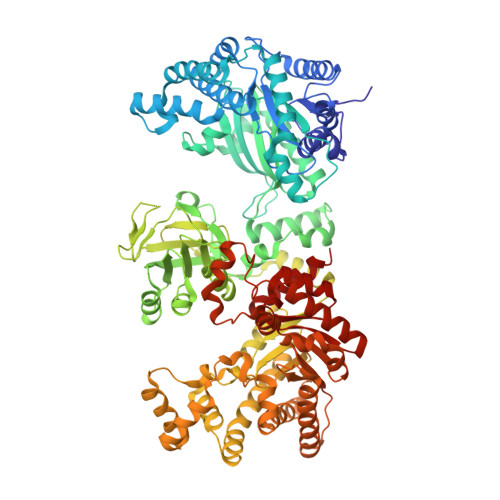Structural intermediates and directionality of the swiveling motion of Pyruvate Phosphate Dikinase.
Minges, A., Ciupka, D., Winkler, C., Hoppner, A., Gohlke, H., Groth, G.(2017) Sci Rep 7: 45389-45389
- PubMed: 28358005
- DOI: https://doi.org/10.1038/srep45389
- Primary Citation of Related Structures:
5JVJ, 5JVL, 5JVN - PubMed Abstract:
Pyruvate phosphate dikinase (PPDK) is a vital enzyme in cellular energy metabolism catalyzing the ATP- and P i -dependent formation of phosphoenolpyruvate from pyruvate in C 4 -plants, but the reverse reaction forming ATP in bacteria and protozoa. The multi-domain enzyme is considered an efficient molecular machine that performs one of the largest single domain movements in proteins. However, a comprehensive understanding of the proposed swiveling domain motion has been limited by not knowing structural intermediates or molecular dynamics of the catalytic process. Here, we present crystal structures of PPDKs from Flaveria, a model genus for studying the evolution of C 4 -enzymes from phylogenetic ancestors. These structures resolve yet unknown conformational intermediates and provide the first detailed view on the large conformational transitions of the protein in the catalytic cycle. Independently performed unrestrained MD simulations and configurational free energy calculations also identified these intermediates. In all, our experimental and computational data reveal strict coupling of the CD swiveling motion to the conformational state of the NBD. Moreover, structural asymmetries and nucleotide binding states in the PPDK dimer support an alternate binding change mechanism for this intriguing bioenergetic enzyme.
- Cluster of Excellence on Plant Sciences (CEPLAS), Institute of Biochemical Plant Physiology, Heinrich Heine University Düsseldorf, 40204 Düsseldorf, Germany.
Organizational Affiliation:



















